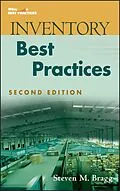The latest and most important information for best practices in
the inventory function
Inventory Best Practices, Second Edition offers the
latest and most important information on advanced techniques and
strategies to improve on the accuracy of all ongoing inventories,
configure a warehouse for optimum counting efficiencies, and
more.
* Explains the difference between different types of distressed
merchandise for disposal purposes
* Shows how to maximize the efficiency of inventory tracking
systems by shifting selected inventory items into floor stock
* Examines inventory picking, storage, transactions as well as
warehouse layouts, and inventory measurement
Inventory Best Practices, Second Edition will not only
show professionals how to cut their business costs but will
demonstrate how to optimize their company's effectiveness as
well.
Autorentext
STEVEN M. BRAGG, CPA, has been the chief financial officer or controller of four companies, as well as a consulting manager at Ernst & Young and auditor at Deloitte. He is the author of over thirty books primarily targeted toward controllers, treasurers, CFOs, and their needs. Bragg received a master's degree in finance from Bentley College, an MBA from Babson College, and a bachelor's degree in economics from the University of Maine.
Zusammenfassung
The latest and most important information for best practices in the inventory function
Inventory Best Practices, Second Edition offers the latest and most important information on advanced techniques and strategies to improve on the accuracy of all ongoing inventories, configure a warehouse for optimum counting efficiencies, and more.
- Explains the difference between different types of distressed merchandise for disposal purposes
- Shows how to maximize the efficiency of inventory tracking systems by shifting selected inventory items into floor stock
- Examines inventory picking, storage, transactions as well as warehouse layouts, and inventory measurement
Inventory Best Practices, Second Edition will not only show professionals how to cut their business costs but will demonstrate how to optimize their company's effectiveness as well.
Inhalt
Preface xv
Chapter 1 Success or Failure with Best Practices 1
Types of Best Practices 1
Most Fertile Ground for Best Practices 2
Planning for Best Practices 3
Timing of Best Practices 5
Implementing Best Practices 6
How to Use Best Practices: Best Practice Duplication 9
Why Best Practices Fail 10
Summary 14
Chapter 2 Inventory Purchasing 15
2.1 Include Suppliers in the New Product Design Process 17
2.2 Use Supplier-Concurrent Engineering 18
2.3 Avoid Designing Risky-Procurement Items into Products 18
2.4 Match Product and Part Life Cycles 19
2.5 Reduce Safety Stocks by Shrinking Supplier Lead Times 20
2.6 Purchase Supplier Capacity 20
2.7 Reduce Safety Stocks by Accelerating the Flow of Internal Information 21
2.8 Buy from Suppliers Located Close to the Company 22
2.9 Relocate Suppliers On-Site 23
2.10 Use Local Suppliers for Rapid Replenishment 24
2.11 Consider Foreign Sourcing 24
2.12 Use Auctions for Selective Purchases 25
2.13 Compare Suppliers Based on Total Landed Cost 26
2.14 Eliminate Approvals of Routine Purchases 27
2.15 Purchase Based on Material Requirements Planning 27
2.16 Compare Open Purchase Orders to Current Requirements 28
2.17 Freeze the Short-Term Production Schedule 29
2.18 Share Production Plan with Suppliers 30
2.19 Obtain Direct Links into Customer Inventory Planning Systems 30
2.20 Require Frequent Deliveries of Small Quantities 31
2.21 Arrange for Inbound Split Deliveries 33
2.22 Arrange for Phased Deliveries 33
2.23 Adopt Rolling Schedules 34
2.24 Adopt Just-in-Time Purchasing 35
2.25 Implement Stockless Purchasing 36
2.26 Centralize Purchasing 37
2.27 Designate Major Suppliers as Lead Suppliers 37
2.28 Single-Source Products 38
2.29 Install a Supplier Rating System 40
2.30 Use Long-Term Supplier Relationships for Strategic Purchases 41
2.31 Shift Raw Materials Ownership to Suppliers 42
2.32 Flag Changes Impacting Advance Material Requests 44
Chapter 3 Inventory Receiving and Shipping 45
3.1 Reject Unplanned Receipts 45
3.2 Obtain Advance Shipping Notices for Inbound Deliveries 47
3.3 Directly Enter Receipts into Computer 48
3.4 Automatically Collect Inbound and Outbound Cube and Weight Information 49
3.5 Repackage Incoming Items into Increments Ordered by Customers 50
3.6 Put Away Items Immediately after Receipt 51
3.7 Stage Received Goods for Zone Putaways 52
3.8 Eliminate the Receiving Function 53
3.9 Combine the Shipping and Receiving Functions in One Area 54
3.10 Assign Docks Based on Minimum Warehouse Travel Time 55
3.11 Require Supplier Deliveries with Open-Sided Trucks Directly to Production 55
3.12 Ship Using Returnable Wheeled Containers 56
3.13 Use Dunnage Bags to Cushion Outbound Shipments 57
3.14 Use Shippers with the Most Consistent Delivery Performance 58
3.15 Have Delivery Person Deliver the Invoice 59
3.16 Pay Suppliers Based Only on Receiving Approval 60
3.17 Provide Pending Shipment Information to the Collections Staff 63
Chapter 4 Inventory Storage 65
4.1 Drop Ship Inventory 67
4.2 Cross-Dock Inventory 67
4.3 Move Inventory to Floor Stock 68
4.4 Use Temporary Storage for Peak Inventory Requirements 70
4.5 Assign Unique Location Codes to All Inventory Storage Locations 71
4.6 Reduce the Number of Inventory Bin Locations Assigned to the Same Product 72
4.7 Assign Fixed Inventory Locations to High-Volume Items 72
4.8 Segregate Customer-Owned Inventory 73
4.9 Allocate Warehouse Areas to Specific Customers 74
4.10 Segregate Inventory by ABC Classification 75
4.11 Store High-Pick Items in Order Fulfillment Zones 76
4.12...
